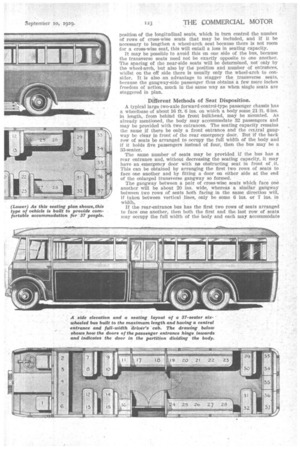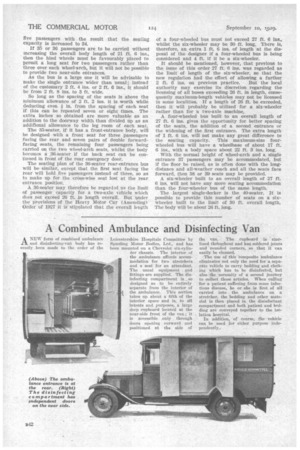PLANNING PASSENGER ACCOMMODATION on Large Single deckers
Page 66

Page 67

Page 68

If you've noticed an error in this article please click here to report it so we can fix it.
A Discussion on the Merits of the Different Means for Obtaining Maximum Seating Capacity Commensurate with Comfort.
THE largest single-decker in common use is a forward-control vehicle measuring about 26 ft. in overall length and seating about 32 passengers. This number of seats may be provided when there are both front and rear entrances ; consequently, there is scope for a slight increase in seating capacity if the bus has only one entrance. Again, one bus may have slightly more passenger accommoila.tion than another, because it has more body space in proportion to the overall length of the chassis.
From the bodybuilder's point of view the two-axle chassis is a simpler problem than the three-axle one, owing to the difference in the length of wheel-arch required. The wheel-arches determine the position of the longitudinal seats, which in turn control the number of rows of cross-wise seats that may be included, and if it be necessary to lengthen a wheel-arch seat because there is not room for a cross-wise seat, this will entail a loss in seating capacity.
It may be possible to avoid this on one side of the bus, because the transverse seats need not be exactly opposite to one another. The spacing of the near-side seats will be determined, not only by the wheel-arch, but also by the position and number of entrances, whilst on the off side there is usually only the wheel-arch to consider. It is also an advantage to stagger the transverse seats, • because the gangway-side passenger thus obtains a few more inches freedom of action, much in the same way as when single seats are staggered in plan.
Different Methods of Seat Disposition.
A typical large two-axle forward-control-type passenger chassis has a wheelbase of about 16 ft. 6 ins, on which a body some 21 ft. 6 ins. in length, from behind the front bulkhead, may be Mounted. As already mentioned, the body may accommodate 32 passengers and may be provided with two entrances. The seating capacity remains the same if there be only a front entrance and the cerztral gangway be clear in front of the rear emergency doer. But if the back row of seats be arranged to occupy the full width of the body and if it holds five passengers instead of four, then the bus may be a 33-seater.
The same number of seats may be provided if the bus has a rear entrance and, without decreasing the seating capacity, it may have an emergency door with no obstructing seat in front of .it. This can be obtained by arranging the first two rows of seats to face one another and by fitting a door on either side at the end of the enlarged transverse gangway so formed.
The gangway between a pair of cross-wise seats which face one another will be about 20 ins, wide, whereas a similar gangway between two rows of seats both facing in the same direction will, if taken between vertical lines, only be some 6 ins. or 7 ins, in width, If the rear-entrance bus has the first two rows of seats arranged to face one another, then both the first and the last row of seats may occupy the full width of the body and each may accommodate Bye passengers with the result that the seating capacity is increased to 34.
If 35 or 36 passengers are to be carried without increasing the overall body length of 21 ft. 6 ins., then the hind wheels must be favourably placed to permit a long seat for two passengers .rather than three over each wheel-arch, but it will not be possible to provide two near-side entrances.
As the bus is a large one it will be advisable to make the single entrance wider than usual; instead of the customary 2 ft. 4 ins. or 2 ft. 6 ins., it should be from 2 ft. 8 ins, to 3 ft. wide.
So long as the spacing of the seats is above the minimum allowance of 2 ft. 2 ins. it is worth while deducting even I in. from the spacing of each seat if this can be repeated seven or eight times. The extra inches so obtained are more valuable as an addition to the doorway width than divided up as an additional allowance to the leg room of each seat.
The 35-seater, if it has a front-entrance body, will be designed with a front seat for three passengers facing the rear and seven pairs of double forwardfacing seats, the remaining four passengers being carried on the two wheel-ar-eh seats, whilst the body becomes a .36-seater if the back seat can be continued in front of the rear emergency door. .
The seating plan of the 36-Seater rear-entrance bus will be, similar, except that the first seat facing the rear will hold five passengers instead of three, so as to make up for the cress-wise seat lost at the rear entrance position-.
A .36-seater may therefore be regard-10 as the limit of passenger • capacity. for a two-axle. vehicle which does, not exceed 26 ft. in length overall. But under the provisions of the Heavy Meter Car (Amending) Order of .1927 it is stipulated that. the overall length of a four-wheeled bus must not exceed 27 ft. 6 ins., whilst the six-wheeler may be 30 ft. long. There is, therefore, an extra 1 ft. 6 ins, of length at the disposal of the designer if a four-wheeled bus is being considered and 4 ft. if it be a six-wheeler.
It should be mentioned, however, that previous to the issue of this order 27 ft. 6 ins, was regarded as the limit of length of the six-wheeler, so that the new regulation had the effect of allowing a further
2 ft. 6 ins, on previous practice. But the local authority may exercise its discretion regarding the licensing of all buses exceeding 26 ft. in length, consequently maximum-length vehicles may not be licensed in some localities. If a length of 26 ft. be exceeded, then it will probably be utilized for a six-wheeler rather than for a two-axle machine.
A four-wheeled bus built to an overall length of 27 ft. 6 ins, gives the opportunity for better spacing of the seats, the addition of a second entrance or the widening of the first entrance. The extra length of 1 ft. 6 ins, will not make any great difference to the seating capacity. This maximum-size fourwheeled bus will have a wheelbase of about 17 ft. 6 ins., with a body space about 22 ft. 3 ins. long.
With the normal height of wheel-arch and a single entrance 37 passengers may be accommodated, but if the floor be raised, as is often done with the longdistance and all-weather coach and all the seats face forward, then 38 or 39 seats may be provided.
A six-wheeler built to an overall length of 27 ft. 6 ins, will not have any more seating accommodation than the four-wheeler bus of the same length.
The largest single-decker is the 40-seater. It is possible to provide this number of seats on a sixwheeler built to the limit of 30 ft. overall length. The body will be about 26 ft. long_




















































































































